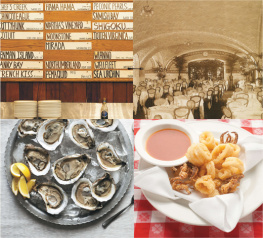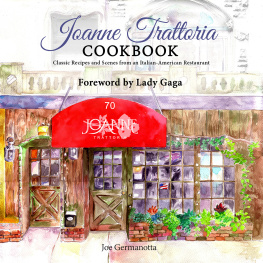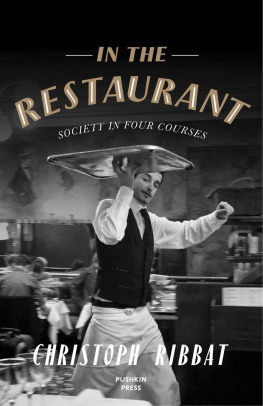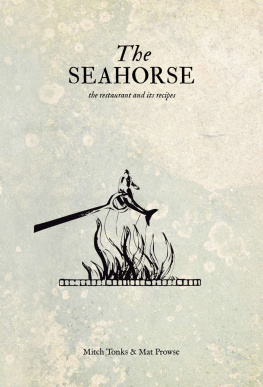
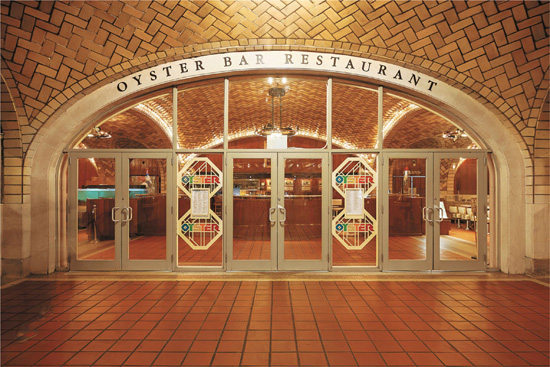



The Oyster Bar, 1940s
CONTENTS

Mr. Brody, standing at the oyster bar.
PREFACE
In his introduction to the 1977 Grand Central Oyster Bar & Restaurant Seafood Cookbook, Jerome Brodythe man who created the Oyster Bar we know todaywrote:
We are proud to be associated with The Oyster Bar at Grand Central Station. This landmark seafood palace continues to be a New York institution, and we pledge to keep it that way. The Grand Central Oyster Bar & Restaurant Seafood Cookbook details many of our efforts in endeavoring to purchase an outstanding variety of the freshest fish available, both those fish that are well known, and others that are less familiar. We urge you to do the same. Support your local fishing industry. Here youll find the best source of seafood for your kitchen. Visit the ports near you, whether ocean or freshwater, and buy from the most primary resource. Or better still, do your own fishing and encourage neighbors, friends, and relatives to do the same. No matter how involved or simple the preparation of any dish, you must always use fresh fish. Happily, the world has awakened to the problems of water pollution, and once again our many seas, rivers, and lakes will be plentifully stocked.
There are more water-based cities and villages in the world than there are landlocked ones, and the variety of seafood cuisines is immense and fascinating. Though The Oyster Bar serves many of these regional and ethnic specialties, we are constantly searching for and developing others. Again, we urge you to do the same in your own kitchen. Aquiculture is growing, and it will help provide us with many of the proteins the world seeks. Above all, the correct handling and preparation of fresh fish will increase your familys, the nations, and the worlds appetite for this most helpful of foods. We shall do our best to help.
We still have much the same philosophy at the Oyster Bar, with more awareness of sustainability and the health of the oceans. We follow the regulations set by states, which control specific waters, and we firmly believe that this is the road to sustainability.

Alain/The New Yorker; Cond Nast
A 1941 cover of The New Yorker

GUASTAVINO TILES
Architect and builder Rafael Guastavino was born in Valencia, Spain, in 1842 and came to New York City in 1881. Guastavino had built vaulted houses in Spain using clay tiles set in mortar and continued to refine this traditional techniquecalled bveda catalana, or Catalan vaultto make vaults that could span relatively large distances. He patented his Tile Arch System in 1885.
His first major commission came from McKim, Mead & White, who asked him to create vaulting for the Boston Public Library. Guastavinos graceful vaults can be seen in many New York City locations, including the Elephant House at the Bronx Zoo, the Great Hall at Ellis Island, and the market under the Ed Koch Queensboro Bridge.
The large vault at the entrance of the Oyster Bar has long been known as the Whispering Gallery and is considered one of the secrets of Grand Central Terminal. Stand facing into one corner with a friend in the opposite corner, speak in a normal tone, and your voice follows the curvature of the ceiling, says urban historian Justin Ferate. Its called telegraphing. Your friend will hear you as clearly as if you were having a conversation face-to-face.
The hostesses at the Oyster Bar have witnessed many a marriage proposal in the Whispering Gallery. And guests in the dining room are still discovering spots where conversation carries across the room.
A SHORT HISTORY OF A LANDMARK RESTAURANT
THE YEAR WAS 1913, and a Beaux Arts masterpiece had just opened its doors in New York City. More than 150,000 people were said to have visited Grand Central Terminal that first day in February and marveled at its wonders.
Not all the wonders had to do with modern train travel, though. Down the ramp that led to the suburban concoursean idea borrowed from the sloping roads that led the way for the chariots into the old Roman camps of Julius Caesars army, reported the New York Timeswas a new restaurant with the Whispering Gallery as its entrance.
What wasand still ismost striking to the visitor walking into the restaurant is the shallow, five-vaulted tiled ceiling designed by Rafael Guastavino, which runs from the end of the dining room to the Saloon. The rectangular terra-cotta tiles, in various shades of blond and tan, were set in a herringbone pattern, and, at the time, a chandelier hung from the peak of each vault. The floor was covered in Persian carpets; potted palms sprung up among the tables.
The Union News Company won the bidding to manage the new restaurant, and they selected Viktor Yesenskya Slovak who was then in charge of the oyster bar at the Knickerbocker Hotelto take the helm.
It was the era of elegant train travel, and long-distance travelers on the Fast Mail or the 20th Century Limited stopped to dine at the Oyster Bar before boarding their trains. Commuters to Yonkers or New Rochelle, too, stopped for a plate of oysters or a quick bowl of oyster stew. But society came as well: Diamond Jim Brady and Lillian Russell were among the many New Yorkers to dine in splendor under Guastavinos vaults.
Mark Helprin, in Winters Tale, imagines the scene:
It was a fine coincidence that she was standing just outside the Oyster Bar, where rooms of happy diners deep underground ate frothy oyster stews or sizzling fish steaks while white-jacketed barmen served up clams and oysters on a production line worthy of its finer, more anarchic, deeper-underground predecessors.
Lets get some food into you and the child, Praeger said. The maitre d has a very gentle fish porridge for babies; Ive seen him prepare it, and Id eat it myself. And, as for you, may I recommend that you have what were having? Were having some oyster pan roast, grilled haddock fillets stuffed with lobster, roasted potatoes, green peas, and Dutch beer. Its coming all around, and in half a second I can order another place.
Yesensky remained at the Oyster Bar for thirty-three years, and the restaurant continued in its vital role in the New York food scene. Anthony Gil, head waiter in the 1940s, collected autographs of notable diners, including two chief justices of the United States: Charles Evans Hughes and former president William Howard Taft. There were some truly exceptional tastes to be tasted, too, especially in seafood, Jan Morris reported in
Next page
